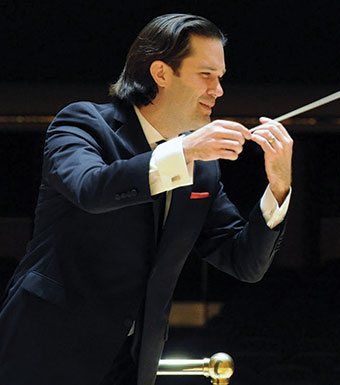Exploring the Eroica
by Jan Jezioro

Matt Kraemer leads the BPO in an exploration of Beethoven’s masterpiece
Several years ago, a professional woman in her 30s, just transferred to Buffalo by her large, international corporation, asked a group of her new co-workers about the cultural scene in Buffalo. Among the many possibilities that were brought up, someone mentioned the wonderful season of classical music concerts offered every year by the Buffalo Philharmonic Orchestra under its internationally acclaimed music director, JoAnn Falletta. The new Buffalo resident, a holder of several advanced engineering degrees from a Big 10 university, replied roughly as follows: “Oh, I don’t know anything about classical music. I never studied music in any way, in either high school or college, and I just feel intimidated by the idea of going to a classical music concert. Why can’t symphony orchestras offer programs that explain classical music to adults like me, who know nothing about it?”
Perhaps someone in the BPO organization overheard that conversation, or similar conversations elsewhere, since this season the BPO initiated a new, three part series, “Know the Score,” which explains selected popular classical music pieces to the audience, who then gets to meet the musicians informally afterwards. The two earlier events in this well received series featured Falletta guiding the audience through a one hour or so long exploration of Rimsky-Korsakov’s much loved exotic tone poem Scheherazade and BPO staff conductor Paul Ferington exploring Impressionism in both art and music, enhanced by the large-screen projection of the images of Impressionist paintings.
On Thursday, May 23 at 7pm, BPO associate conductor Matthew Kraemer, who has established himself as an essential part of the BPO in the few short years that he has been in Buffalo, will lead the orchestra and the audience in an exploration of one of the most original works in the entire classical music repertoire, Beethoven’s masterful Symphony No. 3 in E-flat major, op 55, Eroica.
Beethoven developed rapidly as a composer of symphonies. His Symphony No. 1, written in 1800, is one of his most conservative works, but by the time that he composed his lyrical and highly energetic Symphony No. 2 in 1802, he was well on the way to developing his unique style in what turned out to be one of his most fertile and creative decades. The earliest sketches for the Symphony No. 3 appear to date from the summer or fall of 1802, while most of the work was composed in the latter half of 1803 and the work was completed in early 1804.
The story goes that Beethoven planned to call his new work the Bonaparte symphony, and to dedicate it to Napoleon. In 1838, long after Beethoven’s death, Ferdinand Ries, his pupil and friend, first published his famous description of his mentor’s reaction to the news that Napoleon had himself crowned emperor in May 1804. Beethoven had admired Napoleon for helping spread the French Revolution’s ideals of liberté, égalité, and fraternité to the rest of Europe, and for his military prowess as First Consul. When Ries, who by his own account was “the first to tell him the news that Bonaparte had declared himself emperor, he flew into a rage and shouted, ‘Now he will also trample all human rights underfoot, and only pander to his own ambition: he will place himself above everyone else and become a tyrant!’ Beethoven went to the table, took hold of the title page at the top, ripped it all the way through, and flung it on the floor. The first page was written anew and only then did the symphony receive the title Sinfonia Eroica.”
In another manuscript copy of the symphony, the composer scratched out “Bonaparte” on the title page so violently with a knife that it left a hole in the paper. But, as the musicologist Michael Steinberg has observed, “Actually, Beethoven blew hot and cold on the issue of Napoleon,” citing the fact that in 1810 when Napoleon was at the height of his power Beethoven considered dedicating his great Mass in C to the emperor. And, during the French occupation of Vienna in 1809, Beethoven became friendly with the Baron de Trémont, Napoleon’s Council of State, who later recalled, “Through all his resentment I could see that Beethoven admired Napoleon’s rise from such obscure beginnings.”
In any case, the Eroica ushered in the “heroic period” in Beethoven’s compositional life, and in many ways foreshadowed the following Romantic period in classical music. The Eroica is almost twice the length of the final symphonies by Haydn and Mozart, a length which caused some initial consternation to contemporary audiences, but which showed the future of symphonic composition in the 19th and 20th centuries.
Tickets are $25. For more information, call 885-5000 or visit www.bpo.org.
blog comments powered by Disqus|
Issue Navigation> Issue Index > v12n20 (Week of Thursday, May 16) > Exploring the Eroica This Week's Issue • Artvoice Daily • Artvoice TV • Events Calendar • Classifieds |









 Current Issue
Current Issue